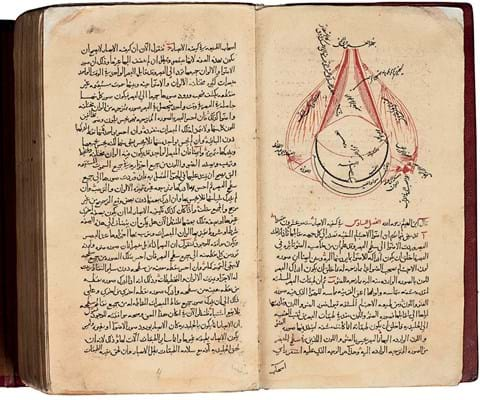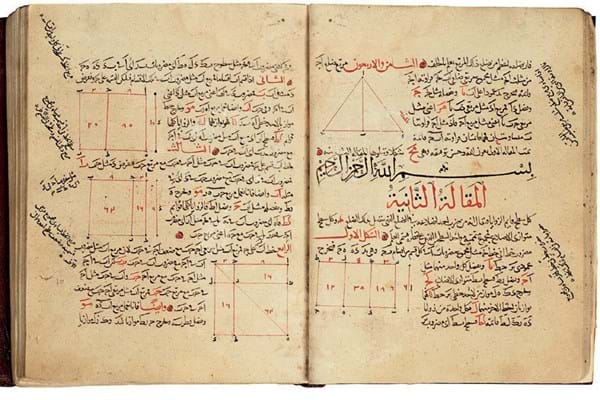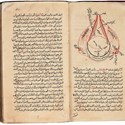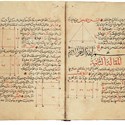Part of a Sotheby’s (25/20/12.9% buyer’s premium) sale of April 25, dated 708AH/1309AD and running to 321 leaves, it is executed in naskh script and illustrated throughout.
The manuscript is an early copy of the Kitab tanqih al-manazir, a landmark work by Kamal al-Din al-Farisi that drew on the writings of Ibn al-Haytham and the earlier Greek scholars, including Euclid, Ptolemy, Aristotle and Galen.
“It covers various elements of optics, the physics of the eye, as well as light, vision, reflection, refraction, and various theories related to mathematics and geometry,” said Sotheby’s, who also noted that the cross-sectional diagram featured on the spread reproduced above may be the earliest recorded medical illustration of the human eye.
Ownership value
Also of considerable significance is the provenance of the manuscript. The various ownership inscriptions added over the years include those of two celebrated Ottoman astronomers of the 16th century: Miriam Celebi and Muhammad Taqi al-Din.
The manuscript is in fact incomplete, the first 17 leaves having been for some time in the collections of the New York Public Library. Those leaves were acquired by Jacob H Schiff, a Jewish-American banker, businessman and philanthropist, from the collections of the Haydari family of scholars and manuscript collectors, who came originally from Baghdad.
After the death of Ibrahim Fasih al-Haydari in 1881, his library was sold and part of it was acquired by Schiff, who in 1934 presented the ‘Optics’ leaves to the NYPL.
Whether the manuscript was complete in the Haydari collection and split at some point between 1881 and Schiff’s acquisition, or had been removed at an earlier date, is unknown.
A Timurid copy of the same work, dated 899AH/1494AD, sold at Sotheby’s in October last year for £88,000.
Bid to £260,000 in the recent Sotheby’s sale was an Arabic translation of Euclid’s Elementa – one that has its origins in the 13th century, as confirmed by a carbondating test.
An Egyptian paper manuscript of 92 leaves, it lacks the first and last pages but is accomplished in an elegant naskh script in black ink, with important words in bolder red and titles in fine red muhaqqaq script.
Illustrated throughout with finely executed geometric diagrams, this courtly manuscript is incomplete and edited, but this significant and previously unrecorded manuscript of Euclid’s great work, said the cataloguer, combines various elements of different transmissions from the original Greek that were circulating at the time.
Compiled well over 2000 years ago, Euclid’s textbook on geometry and number theory, it is claimed, has had more readers over the centuries that any work other than the Bible – and until comparatively recently its theorems still formed the basis of school geometry.
Euclid started with 10 ‘common notions’ and ‘postulates’ and derived from them 465 theorems as logical consequences.
The subjects dealt with, noted the cataloguer, “…are mainly geometry: lines, angles, similar and congruent triangles, areas, the theorem inappropriately associated with Pythagoras, circles, polygons, volumes of parallelepipeds, prisms, pyramids, the sphere, but also number theory, including prime numbers and irrational numbers.”
Advanced treatments
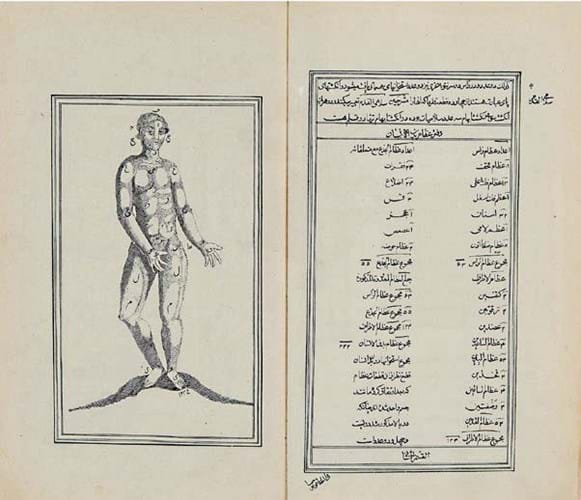
Sold for £5000 in an online Bloomsbury Auctions sale was this 19th century Qajar anatomical treatise.
In a very different price bracket, as well as much later in date and lithographed throughout, was a Qajar anatomical treatise that sold for a 10-times estimate £5000 in an online Bloomsbury Auctions (24/20/12% buyers’ premium) sale of Islamic works on paper that ended on April 27.
With text in Farsi and Arabic, this three-part work, probably produced in Tehran and dated 1855-56, features 55 anatomical plates and related text, as in the spread shown above.
In the medical sciences, said the cataloguer, the Qajar period experienced a movement away from traditional methods of medicine to more advanced practices, drawn in part from Europe.
In the same year that this volume was printed an Austrian physician, Jacob Polak, was appointed royal physician to the court of Naser al-Din Shah, to whom the work is dedicated.
Polak, who had by then written several works on human anatomy and established the first modern course on the subject in the region, may well have been the driving force behind its composition, said Bloomsbury.
Some of the gatherings were coming loose from the black cloth binding but it was generally clean.
As noted in a news item in ATG No 2340, a group of fragments from an 8th century Qu’ran written on scraped and cleaned vellum that still showed traces of its much earlier use in a Coptic Bible made £490,000 in a Christie’s Islamic sale on April 26


